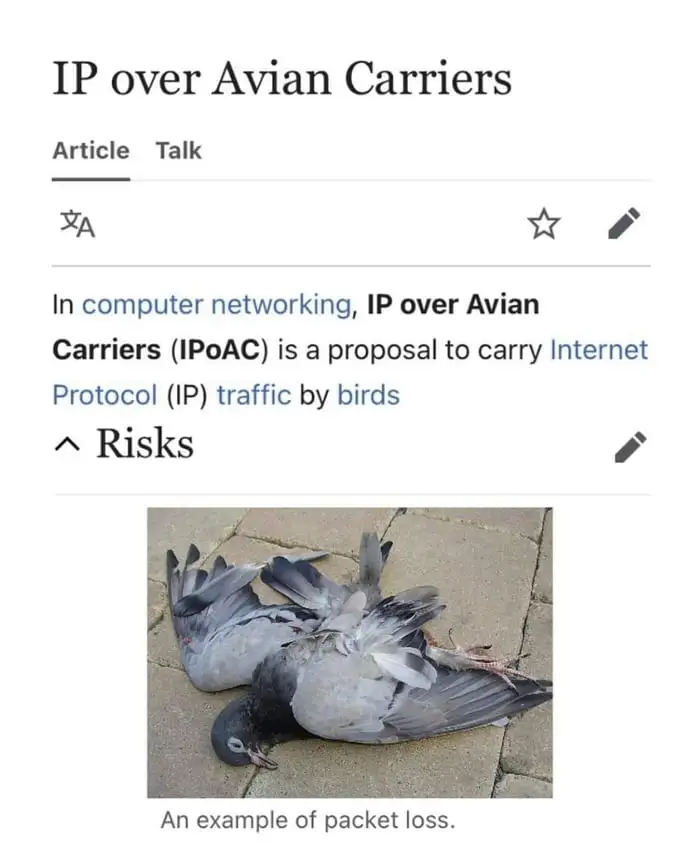- cross-posted to:
- technology@lemmy.ml
- hackernews@lemmy.smeargle.fans
- hackernews@derp.foo
- cross-posted to:
- technology@lemmy.ml
- hackernews@lemmy.smeargle.fans
- hackernews@derp.foo
Ethernet is Still Going Strong After 50 Years::The technology has become the standard LAN worldwide
The only bad thing about Ethernet cables is that they’re shaped like a goddamn grappling hook. If I wanna pull an Ethernet cable through my desk, I must understand that every other cable in its path is coming with it.
always buy the more expensive ones with the foreskin.
The foreskin gets in the way when pulling it out of the port though.
Tell me about it.
Hot
I’m pretty sure your ethernet cable shouldn’t be getting hot
What about getting hot for your Ethernet cable?
Your nice, long, sexy Ethernet cable? With that wide bandwidth? That low latency? I’m getting wet just thinking about it. Let’s LAN party ;)
Choke me daddy
And spank me with this:

I’ve never had that problem 😉
I always crimp my own, including using slide-on/slide-off hoods. That way I can back the hood off before plugging it into the port, which keeps it easy to disconnect, and I can slide it back on before pulling it through a tight spot.
I crimp my own, but never used the hoods before on self made. Usually I run it where it needs to be then put the end on
I’ve never heard it called foreskin, that’s pretty funny, but FYI, the proper term is “boot”. And I’m a big fan of no boots in the rack. They are nice for desks and places cables might be rearranged constantly, but in switches and backs of servers they just slow you down.
Almost spit my coffee out god damn was not ready to read that 😂
Not to be that person but ethernet is the specification, the “grappling hook” you are referring to is the connector (Rj45 8p8c). Ethernet has a ton of different connectors in the spec from SFP to DE-9 and even HDMI.
Tape is your friend, it’s how I pull it through walls.
VGA cables.
Get VGA Today! Comes with double grappling action!
Why not? I prefer a hard wired connection over wifi where possible any day. The speeds are more than adequate for 99.9% of needs, it’s pretty secure, what’s not to like?
The speeds of wired ethernet are typically faster than wifi, and are consistantly more reliable.
I’ve worked in RF for my entire career, and I’ll always recommend a wired solution as the best option unless the use case requires the hardware to be moving arbitrarily.
If it doesn’t move… it deserves a hard line. No point in spending precious wireless capacity on something that’s so well served by a cable.
The amount of splitters I’d require and the cost of those splitters tends to be the thing that stops me from doing that
A basic 48 port switch is ~$200… https://www.amazon.com/dp/B004UBUJZG
I can guarantee that your house doesn’t need more than that.
And 8 port switch can be had for as cheap as $18… https://www.amazon.com/dp/B00A121WN6/
Hmm I’ll look more into that but I think I stand corrected so thanks for that info
Tell me how you didn’t read the article…
Wifi (802.11) is a type of ethernet. Ethernet is the communication specification not the medium.
I’m really confused by the number of people here that are conflating Ethernet as a protocol and the physical medium it runs over. Coxial, fiber, and twisted pairs, can all carry different protocols. None of them are as ubiquitous in the home as Ethernet. Alternative network technologies are usually specific purpose, like fibre channel for storage, or infiniband for low latency, or 5G for wireless telecommunications.
It’s a very long lived protocol and it’s a testament to its lightweight and flexible nature. Ethernet really is a framework for higher level protocols where increasing change happens. IP addresses? Not Ethernet, that’s all Internet protocol. It’s more reminiscent of when electricity in the home was becoming common place. Before standardisation there was all kinds of chaos with different sockets, voltage, AC vs. DC etc. Although arguably that’s a less settled debate with suppliers and home users often preferring different standards.I just want to say that my home network is entirely ethernet, and I have a few fiber connections in there that are also ethernet.
The vast majority of the ethernet connections out there are done over category (5/5e/6/6a) cable, at least when it comes to end users, but that’s not the only thing that can transmit ethernet.
802.11 is extremely similar to ethernet, though, very notably, it is not ethernet. It is ethernet compatible, and mostly just adds things like encryption and source and endpoint radio identifiers… It more adds to ethernet than it changes anything. Bring so similar, the end to end ethernet connection is almost entirely unchanged when there is a wireless link in the chain…
It is, of course, different, as it has some different methods for handling issues, and other things, but ethernet is in there.
Fact is, ethernet is not your category cable, nor your 8p8c “rj45” cable connectors.
There are so many protocols and standards that work together to make networks function that many have not observed outside of the practical application of LAN networks. Thus all the terms get conflated together because the vast majority have not observed these things used in any other context.
Category cable is just a standard for twisted pair wiring. “Rj45” is actually a very specific connector and signaling that has nothing to do with LAN networks. Most of the wiring standards used are born from other purposes, and few know the history behind it.
Oh well. It’s not worth getting upset about it.
I was having a discussion about this with a colleague at work about the so-called “HDMI over Ethernet” and how it’s a misnomer. As you said, Ethernet is a protocol, not a physical medium. I know a lot of people refer to the cable as “Ethernet cable” but the HDMI signal is being sent over CAT6 cables. There’s no encapsulation into Ethernet frames being done.
Didn’t he say that it’s a framework for protocols, not a protocol? Or am I parsing the comment incorrectly?
Eh, it’s both. Ethernet is layer 2. It is your MAC address, more or less. There’s some functionality to it beyond simple hardware addressing, but it provides a scaffold for other, higher layer protocols to operate on top of.
So ethernet, in and of itself is a protocol, and it also provides a framework for other protocols like IP.
Ah, that makes sense, thanks!
If I’m talking to a client and say, “All you gotta do is plug in the Ethernet and power to the NUC I sent you.”, they know what that means.
Vernacular vs. technical usage.
It’s really cool how a lot of the tech that powers the Internet today has a looong legacy. The longevity is astounding!
I watched someone set up their own dial-up ISP on youtube, they were able to consume the modern net with it as well.
Let’s also mention how cheap basic managed and unmanaged switches are today. I just bought a couple to improve my wiring situation.
Even proper managed switches! Our clients, “I can’t find a free port to plug in the computer you sent.”
“Is it really worth losing your whole business for a day because you don’t have a $150 Dell from eBay?!”
And these particular businesses make all their money on one day of the week!
Removed by mod
Ethernet is gonna be, if its not already, one of those lifetime IEC standards that everyone has to support similar to how there are 20 different power plug standards, and someday USB will replace those. Boy, Ethernet over USB. That’ll be the day…
250 years from now they’ll be running Cat6 in mega-spaceships because it works, and the error-correction will be good enough for cosmic ray noise.
Carrier Pigeon with a 4TB m.2 strapped to it’s back baby!
Long ping times but really decent throughput with running your data over avian carrier.

RIP in packet loss birb.
Ok now I’m curious what I’m missing out on. Can anyone recommend a good PCIe token ring adapter and concentrator?
I’m looking for a router that can bridge 10G optical SFP+ to thinnet 10-base-2 coax
Hmm I’ve got an old Compaq 575e with a PCNet32 nic, and an old 3com 3c509 ISA adapter in a closet with 10base2 and AUI ports.
Use a modem router or managed switch to get down to 100baseT, give this box a Linux distro, enable Ethernet bridging in the kernel, and slaps case this baby can drop almost 20k packets a second, no sweat!
Why wouldn’t it be? I don’t understand the point of this article. It’s not like some other direct P2P communication medium is going to come along and upend it. It doesn’t really make sense to run fiber inside your home. You don’t need that kind of bandwidth for such a small number of devices and it would be prohibitively expensive since you need a specialized, highly trained technician to run it - unlike Ethernet, where any sufficiently motivated person can do so. I’ve heard that the people that run fiber for ISPs make something like $200/hr or so.
You’re saying “Ethernet” but what you mean is BASE-T (aka Cat5, Cat6, etc). Ethernet runs over fiber just as well as twisted pair copper.
The OSI model says hi 👋
Here welding fiber is part of pretty basic sparkie training. I’d be surprised if they’d make more than doctors.
- Running fibre really isn’t as complicated as you make it out to be. The only problem is that you can’t do any 90° turns, so just running it along the walls isn’t possible. And the fact that the lasers each cost about 30€ for your standard 10G connection isn’t really helping either.
And I really would like to see the job where running fiber gets you $200/hrs, i would switvh to there on the spot. The most complicated part is splicing 2 cables together and that isn’t all too hard with the right tools and machines.
- The article isn’t talking about cables at all, but rather the ethernet protocol that is used as a standard for data transfer for a long time now. It has nothing to do with the debat over fiber vs. copper.
Maybe I’m missing something but shouldn’t something like this armoured fibre be fine to run inside your walls?
It falls under the low voltage // communications lines in most US states, so standard electricians union pay. It’s pretty good, but not $400,000 salary good.
Depends entirely what type of fiber you want to run. I wouldn’t consider running fibre strands in the home but normal jacketed fiber can be run without anything specialised. The armoured stuff can take a lot more abuse than a standard “Ethernet” cable.
Gonna need ETHERNET2 to power my WEB3.
Why wouldn’t it be?
One person wrote an article on it a few weeks ago and for some reason everyone clicked on it, so now similar articles are being written to capitalize on that success.
YOU DOUBT THE POWER OF SNAKEY BOI?
I think MIDI is going on 40 years now as well
deleted by creator
… Then we can reuse the solution, sprinkle some unnecessary features, and then resell it as the evolution of a thing and make a butt load of money
First thing that came to mind was that it clearly wasn’t developed by Google! Thank goodness. It’d be long dead.
Ethernet is an standard. as long as standards are open (and they should be, by definition) they can’t die as long as there is an use for them.
Google has so much pull now that they alone can define a “web standard” by adding it to Chromium/Chrome. If it’s there for more than a year and used by major websites, people will ever forgot it wasn’t agreed upon by all parties. Any other browser will implement it simply because of the market share.
Well that’s good
Guess it’ll be a while still, until we get optical only setups at home.










